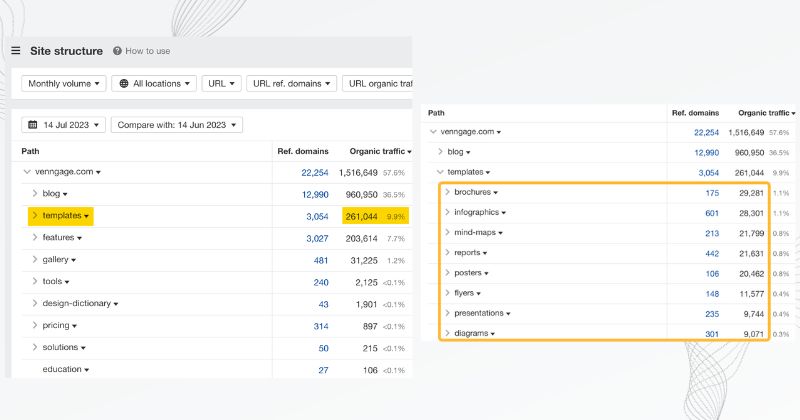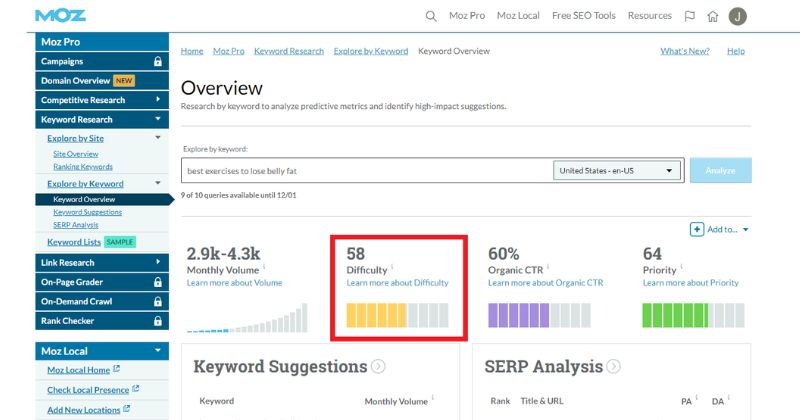Creating content around low competition keywords is like finding a hidden treasure in the big SEO ocean. These keywords are gems because they open doors to untapped traffic potential. They are often overlooked by bigger players, giving you a unique advantage to capture a niche audience.
As someone with extensive experience in SEO, I’ve seen firsthand the power of targeting low competition keywords. They offer a strategic pathway for your content to rank higher on search engines without battling against the big players. This approach is especially beneficial for bloggers and small businesses needing to maximize online visibility with limited resources.
By focusing on low competition keywords, you’re aiming for better search engine rankings and cultivating a more engaged and targeted audience. This strategy paves the way for you to cut through the noise of the high completion keywords. Let’s get to it.
Utilize Free Tools for Low Competition Keyword Research
To effectively find low competition keywords for your SEO strategy, it is crucial to utilize free keyword research tools.
These tools can provide valuable insights and data to help you identify keywords with less competition, giving you a better chance of ranking higher in search engine results. Here are some key tips on how to make the most of these tools:
Google Keyword Planner
Google Keyword Planner is a powerful tool for discovering relevant keywords and analyzing their search volumes. To use it effectively:
- Start by entering a seed keyword or phrase related to your niche.
- Explore the list of suggested keywords, including topics, phrases, sites, and questions generated by the tool.
- Look for keywords with moderate search volumes and low competition.
- Analyze the tool’s trends and historical data to understand keyword performance over time.
Pros:
- Provides accurate search volume data directly from Google.
- Offers insights into keyword trends and historical performance.
Cons:
- Requires a Google Ads account (free) to access all features.
- Limited in terms of competitor analysis and backlink profile information.
In addition to Google Keyword Planner, there are other free tools available that can enhance your low competition keyword research process:
Ubersuggest
Ubersuggest is a tool that offers comprehensive keyword suggestions for sites and phrases. It provides important metrics such as search volume, CPC (Cost Per Click), SEO difficulty, and paid difficulty. It also offers insights into top-ranking pages for specific keywords, allowing you to analyze their content strategies on various sites.
Pros:
- Offers detailed keyword metrics, including SEO difficulty.
- Provides competitor analysis for a better understanding of the competitive landscape.
Cons:
- Some advanced features require a paid subscription.
AnswerThePublic
AnswerThePublic is a unique tool that helps you discover long-tail keywords by generating questions and phrases related to your seed keyword. It provides valuable insights into what people are searching for, allowing you to tailor your content to match their queries.
Pros:
- Generates a wide range of long-tail keyword ideas.
- Helps understand user intent and create targeted content.
Cons:
- Limited in terms of search volume and competition data.
By leveraging these free tools, you can uncover low competition keywords that have the potential to drive organic traffic to your website. Remember to focus on keywords with moderate search volumes and lower competition levels, as they offer a better chance of ranking higher in search engine results.
Identify Low Competition Keywords with High Traffic

In the world of SEO, finding the right keywords is crucial for driving organic traffic to your website. However, it’s not just about targeting high search volume keywords; you must also consider the competition.
Balancing traffic potential and competition is key to achieving success in keyword selection. Here are some strategies to help you identify low competition keywords with good traffic.
Long-tail keyword strategy for finding low competition keywords with moderate traffic
One effective approach is to focus on long-tail keywords. These are longer, more specific keyword phrases with lower search volumes and less competition.
By targeting these long-tail keywords, you can tap into a niche audience more likely to convert into customers.
For example, instead of targeting “running shoes,” you could target “best running shoes for flat feet.” This way, you narrow down your audience and increase your chances of ranking higher in search results.
Using modifiers and qualifiers to refine keyword ideas
Another strategy is to use modifiers and qualifiers when brainstorming keyword ideas. Modifiers add specificity or variation to a base keyword, while qualifiers provide additional context or intent.
By incorporating these into your keyword research, you can uncover hidden gems with lower competition but still have good traffic potential.
Let’s say you run an online pet store and want to find low competition keywords related to dog food. You could add modifiers like “organic,” “grain-free,” or “affordable” before the main keyword “dog food.”
This would give you variations such as “organic dog food brands” or “affordable grain-free dog food.” These modified keywords can help you discover untapped opportunities in your niche.
Utilizing free tools for keyword research
Several free tools can provide valuable insights for low competition keywords with good traffic. Tools like Google Keyword Planner, Ubersuggest, and Answer the Public can help you identify keyword ideas, search volumes, and competition levels. By leveraging these tools, you can gather data-driven insights to decide which keywords to target.
Monitoring and adapting your strategy
Once you’ve identified low competition keywords with good traffic potential, monitoring their performance and adapting your strategy continuously is important.
Monitor your website analytics to see how well these keywords drive organic traffic and conversions. If certain keywords are not performing as expected, consider refining or replacing them with new ones that show better results.
Use Google Autocomplete for Keyword Discovery

The Google search bar is not just a tool for finding information; it can also provide valuable insights into user intent. By understanding what people are searching for, you can uncover low competition keywords with good traffic potential.
Insights into User Intent
Users often reveal their intentions When they type in their queries on the Google search bar. By analyzing these search queries, you can better understand what users are looking for and tailor your content accordingly.
For example, if you run a fitness blog and notice that many people are searching for “best exercises to lose belly fat,” you can create content specifically targeting this topic.
Discovering Related Long-Tail Keywords with Autocomplete
Autocomplete suggestions can be a goldmine for discovering related long-tail keywords. As you start typing a keyword or phrase into the Google search bar, it automatically suggests popular completions based on real-time data.
These suggestions give you valuable insights into what other users are searching for, allowing you to identify relevant long-tail keywords with lower competition.
To make the most of autocomplete suggestions:
- Start typing your target keyword or phrase in the search bar.
- Take note of the suggested completions that appear below.
- Look for variations or related terms with less competition but still align with your content.
For instance, if your target keyword is “healthy breakfast ideas,” autocomplete might suggest “healthy breakfast ideas on a budget” or “quick and easy healthy breakfast ideas.” These suggestions indicate additional long-tail keywords that could be worth exploring.
Tips for Using Wildcard Searches
Wildcard searches can further enhance your keyword discovery process when combined with autocomplete suggestions.
Using an asterisk (*) as a placeholder within your search query allows Google to fill in the blank with different keyword variations. This technique can help you uncover even more low competition keywords.
Here’s how to use wildcard searches effectively:
- Start by typing your target keyword or phrase, leaving a space before the asterisk.
- Add an asterisk (*) in the place where you want Google to fill in the blank.
- Take note of the autocomplete suggestions that appear after using the wildcard search.
For example, if you type “best * for beginners” into the search bar, Google might suggest “best workouts for beginners” or “best diets for beginners.” These suggestions can provide valuable keyword ideas that align with your content and have lower competition.
The Secret to Finding Good Low Competition Keywords
To uncover good low competition keywords, it’s essential to understand the concept of search volume versus competition ratio.
By identifying niche-specific keywords with lower competition levels and considering relevance and user intent, you can discover new opportunities for ranking higher in search results.
Understanding search volume vs. competition ratio
When searching for good low competition keywords, it’s important to strike a balance between search volume and competition.
A keyword with high search volume indicates its popularity among users, but it also means more websites compete in ranking for that keyword.
On the other hand, a keyword with low competition may have less search volume but offers a greater chance of ranking higher.
Identifying niche-specific keywords with lower competition levels
One effective strategy is focusing on niche-specific keywords with lower competition levels. These keywords are more specific and targeted, making ranking higher in search results easier.
For example, instead of targeting a broad term like “shoes,” consider longtail phrases like “comfortable running shoes for women.” These longtail phrases attract users with clear intentions and are more likely to convert into customers.
The role of relevance and user intent
Relevance and user intent are significant in selecting good low competition keywords. It’s important to choose keywords that align with the content on your website or blog. When users perform searches, they have specific intentions or questions in mind. By understanding their intent and providing relevant content that answers their queries, you increase your chances of ranking well for those keywords.
Consider conducting thorough keyword research using tools like Google Keyword Planner or SEMrush to gain insights into the relevance and competitiveness of different keywords within your niche.
In addition to these strategies, there are several other factors you should keep in mind when searching for good low competition keywords:
- Analyze competitor websites: Look at what keywords your competitors are targeting and identify any gaps or opportunities they may have missed.
- Use keyword difficulty tools: These tools estimate how difficult it is to rank for a specific keyword. Aim for keywords with lower difficulty scores.
- Leverage longtail keywords: Longtail keywords are longer, more specific phrases with lower competition levels. They can help you target a niche audience and improve your chances of ranking higher.
Remember, finding good low competition keywords requires a combination of research, analysis, and understanding of search intent.
By focusing on niche-specific keywords with lower competition levels and providing relevant content, you can increase your visibility in search results and attract more organic traffic to your website.
Analyzing Competitors’ Websites for Keyword Inspiration

Competitor analysis plays a crucial role in keyword research. By examining your competitors’ websites, you can gain valuable insights into their strategies and identify low competition keywords that can drive website traffic and attract potential customers.
Importance of competitor analysis in keyword research
Analyzing your competitors’ websites allows you to understand the keywords they are targeting and how they optimize their on-page content.
By identifying their successful strategies, you can adapt them to improve your own website’s performance. This process helps you stay ahead of the competition by uncovering untapped opportunities for driving organic traffic.
Techniques for identifying competitors’ target keywords through on-page optimization clues and meta tags
One effective technique is examining the on-page optimization clues on your competitors’ websites. Pay attention to elements such as page titles, headings, meta descriptions, and URL structures. These components often contain relevant keywords that indicate their focus areas.
Analyzing the meta tags used by your competitors can provide further insights into their targeted keywords. Meta tags include the title tag, meta description tag, and meta keyword tag.
While search engines may no longer rely heavily on meta keyword tags, the title and description tags remain essential for optimizing web pages.
Utilizing competitor analysis tools like SEMrush and Ahrefs
Competitor analysis tools like SEMrush and Ahrefs offer comprehensive insights into your competitors’ SEO strategies. These platforms allow you to enter a competitor’s domain or specific URL to discover valuable information about their backlinks, top-ranking pages, organic keywords, and more.
SEMrush provides detailed reports on organic search positions, paid search advertising data, backlink profiles, and content marketing strategies employed by your competitors or other sites within your industry niche.
Ahrefs offers similar capabilities, allowing you to analyze your competitors’ backlink profiles, identify their most linked-to content, and gain valuable insights into their overall link building strategies.
By leveraging these tools, you can uncover the keywords your competitors are targeting and identify gaps in their strategies. This information enables you to refine your own keyword research and develop a more effective SEO strategy.
Estimating Keyword Difficulty and Identifying Low Difficulty Keywords

To effectively optimize your website for search engines, it’s crucial to understand the concept of keyword difficulty.
Keyword difficulty refers to how challenging it is to rank for a particular keyword in search engine results. By analyzing various metrics and factors, you can estimate the level of competition associated with specific keywords.
Use SEO Tools to Find Authority
One way to estimate keyword difficulty is by utilizing metrics such as Moz’s Domain Authority (DA) and Page Authority (PA). These metrics provide insights into the strength and authority of a website’s domain or individual page. The higher the DA or PA score, the more difficult it may be to outrank competitors who have already established their online presence.
Another useful metric is SERP analysis, which examines the current search engine results pages (SERPs) for a given keyword. By evaluating the top-ranking websites’ content quality, backlink profiles, and overall authority, you can gain valuable insights into the level of competition for that particular keyword.
Factors Contributing to High or Low Difficulty Scores
Several factors influence the difficulty scores assigned to keywords. These include:
- Domain Rating: A measure of a website’s overall authority based on its backlink profile.
- Effort: The time, resources, and expertise required to rank for a specific keyword.
- Content Competition: The number and quality of competing web pages targeting the same keyword.
- Backlink Profile: The quantity and quality of backlinks pointing to a webpage or domain.
- Search Volume: The number of monthly searches for a particular keyword.
Understanding these factors allows you to assess whether a specific keyword presents an opportunity or poses significant challenges regarding ranking difficulty.
Strategies for Finding Low Difficulty Keywords
Identifying low-difficulty keywords can be a game-changer for your SEO efforts. Here are some strategies to help you find these valuable opportunities:
- Long-tail Keywords: Focus on longer, more specific keyword phrases with lower search volumes and less competition. These keywords often target a niche audience and can result in higher conversion rates.
- Keyword Difficulty Score: Utilize tools like Moz’s Keyword Explorer or SEMrush’s Keyword Difficulty tool to estimate the difficulty associated with specific keywords. Look for keywords with lower difficulty scores, indicating they may be easier to rank for.
- Competitor Analysis: Analyze the keywords your competitors are targeting and identify any gaps or opportunities they might have missed. You can gain an advantage in search engine rankings by targeting less competitive keywords within your industry.
- Long-form Content: Create comprehensive, high quality content that covers a topic in-depth. I find long-form content typically performs better in search engine rankings and can potentially naturally target low-difficulty keywords.
- Local SEO: If you operate a local business, optimize your website for location-specific keywords with less competition than broader terms.
By implementing these strategies and leveraging keyword difficulty metrics, you can uncover low-difficulty keywords that offer significant potential for improving your website’s visibility in search engine results.
Smart SEO Tactics
Embracing low competition keywords is a smart move for boosting your website’s visibility in search engine results. With the right tools and strategies, you can easily find these keywords and attract more relevant visitors to your site.
Start using tools like Google Keyword Planner and SEMrush for your research. By doing so, you’ll outrank competitors and drive targeted traffic to your site effortlessly.
FAQs
How long does it take for low competition keywords to show results?
The time for low competition keywords to show results in Google SERP can vary, typically ranging from a few weeks to several months. Success depends on factors like content quality, SEO optimization, and website authority. Continuous content updates and strategic SEO practices can accelerate visibility.
Are long-tail keywords considered low competition?
Long-tail keywords are often associated with lower competition in the SEO landscape. These keyword phrases are more specific and target niche audiences, making them less competitive than generic, broad keywords. Due to their specificity, long-tail keywords can be an effective strategy for outranking competitors and gaining visibility in search engine results.
How many low competition keywords should I target?
The number of low-competition keywords to target depends on your website’s size, niche, and resources. It’s advisable to start with a manageable quantity, perhaps 5-10, and gradually expand as you see results. Quality and relevance should always take precedence over quantity in your keyword targeting strategy.
Can I outrank competitors by targeting low competition keywords?
Outranking competitors by targeting low-competition keywords is a viable strategy in SEO. By selecting keywords with less competition, you have a better chance of securing higher rankings in search results. However, success also depends on other factors like content quality, backlinks, and user experience. A comprehensive SEO approach considers all these elements to achieve sustainable success.
Should I only focus on low competition keywords?
While low competition keywords are valuable, an effective SEO strategy should not exclusively focus on them. A balanced approach considers keyword relevance, search volume, and user intent. Targeting a balanced mix of keywords, including medium and high competition, can provide a more comprehensive and successful SEO strategy.

